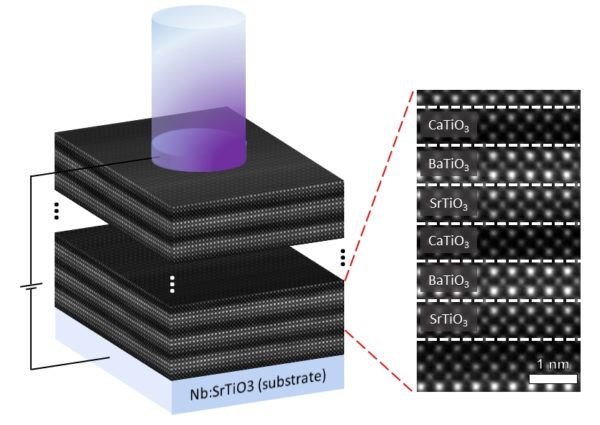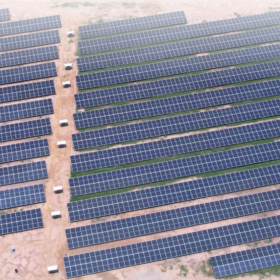From pv magazine International
Combining ultra-thin layers of different materials can raise the photovoltaic effect of solar cells by a factor of 1,000, according to researchers at Martin Luther University Halle-Wittenberg (MLU) in Germany.
Their findings, published in the journal “Science Advances,” described a lattice arrangement of three different layers of ferroelectric crystals (in this case, of barium titanate, strontium titanate, and calcium titanate) that created a powerful solar energy producing effect.
Ferroelectric means that the material has spatially separated positive and negative charges. The charge separation leads to an asymmetric structure that enables electricity to be generated from light.
Ferroelectric crystals differ from conventional silicon cells in that they do not require a p-n junction to create the PV effect. In other words, there is no need to create positively and negatively doped layers within the cell. The researchers said that change could make solar panels easier to produce.
MLU researchers have been experimenting with barium titanate to take advantage of these properties. However, pure barium titanate does not absorb much sunlight; as a result, it generates a relatively low photocurrent. The research showed that combining ultra-thin layers of different materials can significantly increase a cell’s yield.
Researchers added a thin paraelectric layer to the cell. Although this layer does not have separated charges, it can become ferroelectric under certain conditions; for example, in low temperatures or when the chemical structure is slightly modified.
MLU physicist Dr. Akash Bhatnagar and his team discovered that a much stronger photovoltaic effect occurs when the ferroelectric layer alternates with not one, but two different paraelectric layers.
The team embedded barium titanate between strontium titanate and calcium titanate. This was achieved by vaporizing the crystals with a high-powered laser, redepositing them on carrier substrates. The result was a material made of 500 layers that was only about 200 nanometers thick.
The MLU team irradiated the cell with laser light to test the new material, and the results surprised them. Compared to pure barium titanate of a similar thickness, the current flow was up to 1,000 times stronger, despite the proportion of barium titanate having been reduced by almost two-thirds.
“The interaction between the lattice layers appears to lead to a much higher permittivity – in other words, the electrons are able to flow much more easily due to the excitation by the light photons,” Bhatnagar said.
The studies show the effect is also resilient as it remained nearly constant over a six-month test period. Further research is underway to understand what exactly causes this photovoltaic effect.
This content is protected by copyright and may not be reused. If you want to cooperate with us and would like to reuse some of our content, please contact: editors@pv-magazine.com.









What is the Re-Cycling Profile of these “wonderfully powerful” Solar Cells… remember they will last for only 30 years or so and have to be replaced. If the material is so complex that is cannot be recycled (hence the Re-Cycling Profile) …. any benefit arising from higher Outputs/Efficiency are questionable at best and TOTALLY Unacceptable in the Worst Case scenario.
Just a Reminder…. all this Conversion of Fossil/Nuclear Energy Sources to Clean Non-Polluting Solar Panels is to Eliminate Pollute…. not create more… by adding more and more Toxic or Non-Toxic Waste to the ever growing Waste Disposal Facilities around the Globe.
In our quest for Higher Gains, Efficiency etc… let us not forget the raison d’etre, Objective, Goal etc..